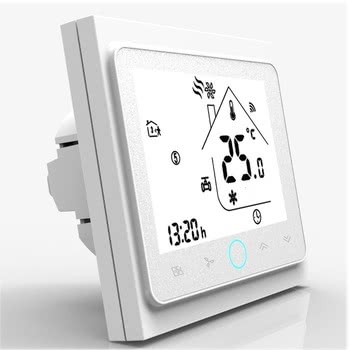Beca Thermostat

The Beca thermostats, also sold under other brand names such as MOES and Qiumi, comprise a series of thermostats that support various configurations, including water heating, water/gas boilers, and electric heating. Some models are WiFi-enabled and can be configured using ESPHome. This allows you to set the target temperature through the Climate component, as well as access internal and external temperature sensors through the Sensor component.
Hardware versions
The hardware comes in multiple versions, including offline-only models (those without a built-in WiFi module), Zigbee-compatible models, and WiFi-enabled versions.
For ESPHome, the WiFi version is required. Please note that WiFi cannot typically be added to the offline variants after purchase due to hardware limitations, so be extra careful when purchasing your thermostat.
Several vendors, such as Beca and MOES, include specific characteristics in the product name. For instance, the WiFi version will include a "W" in its name, like BHT-002-GCLW.
Variants
The product name typically follows the format YYY-NNN-ZZZ (e.g. BHT-002-GCLW), consisting of three parts: the first indicates the mode of operation (BHT for heating only, BAC for Cooling, Heating, and Ventilation), the second specifies the model type (e.g., 002, 006, etc.), and the third part contains additional characteristics, including:
- GA - Water heating
- Two Relays for opening and closing a valve
- Only one Relay will be closed at the same time
- Closing Relay PIN 1 - PIN 3 (N or L)
- Opening Relay PIN 2 - PIN 3 (N or L)
- Max Power: 3A
- GB - Electric floor Heating
- Connect Heating between PIN 1 and PIN 2
- Max Power: 16A
- GC - Water/Gas Boiler
- One Relay - potential free (dry contact)
- Relay on PIN 1 - PIN 2 (dry contacts)
- Max Power: 3A
- L: Backlight
- P: Weekly programmable
- W: WiFi controllable
- Z: Zigbee controllable
- S2: Both internal sensor and floor external sensor
- DB: Dual-band (2.4 GHz/5 GHz)
WiFi modules
The thermostats implement their WiFi functionality through a Tuya MCU WiFi module, that communicates with the main MCU through a UART port.
Earlier models shipped with the Tuya TYWE3S module, which is an Espressif ESP8266-based module. Later models, found in the wild since mid-2021, have replaced the module with the Tuya WB3S module, which is based on the BK7231T chip.
Before the advent of Beken BK72xx support in ESPHome, several users had success by desoldering the WB3S and soldering pinout-compatible Espressif modules such as the ESP12-E. This is not required anymore, as the thermostat has been confirmed to work with the BK7231T support introduced with ESPHome 2023.9.0.
Be aware that the dual-band variants, such as the BHT-002-GCLWDB, ship with the Tuya WBR3D module, utilizing the Realtek RTL8720DN chip. It's important to note that as of late 2023, LibreTiny, and therefore ESPHome, do not offer support for this particular chipset.
Flashing
It is often possible to use tuya-convert for the Espressif-based modules, and tuya-cloudcutter for the Beken-based modules, to flash ESPHome over-the-air, without opening up the thermostat.
Both of these tools rely on exploiting vulnerabilities in the stock Tuya firmware, which may be patched in newer versions, so this may or may not work in your firmware. It is generally advisable to not install firmware updates through the stock smartphone application (Tuya Smart/Smart Life) as this may patch any vulnerabilities that exist in the shipped software.
It is, however, always possible to flash the module through the serial port pins, using esptool for the Espressif-based modules, or ltchiptool for the Beken-based modules, by attaching to the UART pins on the WiFi module, and providing +3.3V and GND directly on the module or in the separate debugging holes the main PCB has. No desoldering is required.
Board Configuration
bk72xx:
board: generic-bk7231t-qfn32-tuya
uart:
rx_pin: RX1
tx_pin: TX1
baud_rate: 9600
time:
- platform: homeassistant
id: ha_time
tuya:
# The MCU uses this for displaying the time in the display as well as for
# scheduled programmes one may have configured in their thermostat.
time_id: ha_time
# (Optional)
# Schedules are not modeled in neither ESPHome nor Home Assistant.
#
# This parses the data point and emitting it as a string in the logs, and
# serves as an example for users desiring more advanced configurations.
on_datapoint_update:
- sensor_datapoint: 101
datapoint_type: raw
then:
- lambda: |-
// Apparently these vary per model; these are valid for the BHT-002
const int POS_HOUR = 1;
const int POS_MINUTE = 0;
const float TEMPERATURE_MULTIPLIER = 0.5f;
const std::map<int, std::string> DAY_OFFSET = {
{0, "days 1-5"},
{6, "day 6"},
{12, "day 7"},
};
for (auto& day : DAY_OFFSET) {
for (int period = 0; period < 6; period++) {
int offset = (day.first + period) * 3;
int hour = x[offset + POS_HOUR];
int minute = x[offset + POS_MINUTE];
float temp = x[offset + 2] * TEMPERATURE_MULTIPLIER;
ESP_LOGD("custom", "Scheduled program for %s %02d:%02d set at %.1f C", day.second.c_str(), hour, minute, temp);
}
}
climate:
- platform: tuya
name: "Thermostat"
switch_datapoint: 1
target_temperature_datapoint: 2
current_temperature_datapoint: 3
eco_datapoint: 5
eco_temperature: 20 °C
temperature_multiplier: 0.5
visual:
min_temperature: 20 °C
max_temperature: 35 °C
temperature_step: 0.5 °C
sensor:
- platform: "tuya"
name: "Temperature"
sensor_datapoint: 3
unit_of_measurement: "°C"
device_class: "temperature"
accuracy_decimals: 1
filters:
- multiply: 0.5
# The climate component already includes temperature, but having the
# temperature as a separate sensor can be useful
disabled_by_default: true
# The external temperature sensor, if wired
- platform: "tuya"
name: "Temperature (external)"
sensor_datapoint: 102
unit_of_measurement: "°C"
device_class: "temperature"
accuracy_decimals: 1
filters:
- multiply: 0.5
disabled_by_default: true
switch:
- platform: "tuya"
name: "Lock"
icon: "mdi:lock"
switch_datapoint: 6
select:
- platform: "tuya"
name: "Scheduled programming"
icon: "mdi:calendar"
enum_datapoint: 4
options:
0: Use scheduled programs
1: Manual control